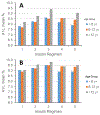Twenty years of pediatric diabetes surveillance: what do we know and why it matters
- PMID: 33543783
- PMCID: PMC8282684
- DOI: 10.1111/nyas.14573
Twenty years of pediatric diabetes surveillance: what do we know and why it matters
Abstract
SEARCH for Diabetes in Youth (SEARCH) was initiated in 2000 as a multicenter study to address major gaps in the understanding of childhood diabetes in the United States. An active registry of youth diagnosed with diabetes at age <20 years since 2002 assessed prevalence, annual incidence, and trends by age, race/ethnicity, sex, and diabetes type. An observational cohort nested within the population-based registry was established to assess the natural history and risk factors for acute and chronic diabetes-related complications, as well as the quality of care and quality of life of children and adolescents with diabetes from diagnosis into young adulthood. SEARCH findings have contributed to a better understanding of the complex and heterogeneous nature of youth-onset diabetes. Continued surveillance of the burden and risk of type 1 and type 2 diabetes is important to track and monitor incidence and prevalence within the population. SEARCH reported evidence of early diabetes complications highlighting that continuing the long-term follow-up of youth with diabetes is necessary to further our understanding of its natural history and to develop the most appropriate approaches to primary, secondary, and tertiary prevention of diabetes and its complications. This review summarizes two decades of research and suggests avenues for further work.
Keywords: epidemiology; health disparities; surveillance; type 1 diabetes; type 2 diabetes; youth.
© 2021 New York Academy of Sciences.
Conflict of interest statement
Competing interests
The authors declare no competing interests.
Figures







References
-
- American Diabetes Association. 2019. 2. Classification and Diagnosis of Diabetes: Standards of Medical Care in Diabetes-2019. Diabetes Care. 42: S13–s28. - PubMed
Publication types
MeSH terms
Grants and funding
- P30 DK057516/DK/NIDDK NIH HHS/United States
- UC4 DK108173/DK/NIDDK NIH HHS/United States
- U18 DP002710/DP/NCCDPHP CDC HHS/United States
- U18 DP006134/DP/NCCDPHP CDC HHS/United States
- U18DP006138/ACL/ACL HHS/United States
- U18 DP002714/DP/NCCDPHP CDC HHS/United States
- U18DP006133/ACL/ACL HHS/United States
- U01 DP000244/DP/NCCDPHP CDC HHS/United States
- P30 DK57516/Barbara Davis Center at the University of Colorado at Denver
- UL1 TR000062/TR/NCATS NIH HHS/United States
- U18DP006131/ACL/ACL HHS/United States
- DP-10-001/CC/CDC HHS/United States
- U01 DP000250/DP/NCCDPHP CDC HHS/United States
- U18 DP002708/DP/NCCDPHP CDC HHS/United States
- U01 DP000247/DP/NCCDPHP CDC HHS/United States
- U18DP006136/ACL/ACL HHS/United States
- U18 DP006131/DP/NCCDPHP CDC HHS/United States
- the Children with Medical Handicaps program managed
- U18 DP006138/DP/NCCDPHP CDC HHS/United States
- UL1 TR000154/TR/NCATS NIH HHS/United States
- U18DP006134/ACL/ACL HHS/United States
- UL1 Tr001450/TR/NCATS NIH HHS/United States
- U01 DP000248/DP/NCCDPHP CDC HHS/United States
- U18 DP006136/DP/NCCDPHP CDC HHS/United States
- U18 DP002709/DP/NCCDPHP CDC HHS/United States
- U18 DP006133/DP/NCCDPHP CDC HHS/United States
- NH/NIH HHS/United States
- UL1 TR001425/TR/NCATS NIH HHS/United States
- Kaiser Foundation Health Plan
- U18 DP006139/DP/NCCDPHP CDC HHS/United States
- South Carolina Clinical & Translational Research Institute
- UL1 TR000077/TR/NCATS NIH HHS/United States
- DP-05-069/CC/CDC HHS/United States
- UL1 TR00423/Seattle Children's Hospital and the University of Washington
- R01 DK127208/DK/NIDDK NIH HHS/United States
- UL1 TR000423/TR/NCATS NIH HHS/United States
- U18DP006139/ACL/ACL HHS/United States
- U01 DP000246/DP/NCCDPHP CDC HHS/United States
- U01 DP000254/DP/NCCDPHP CDC HHS/United States
LinkOut - more resources
Full Text Sources
Other Literature Sources
Medical

